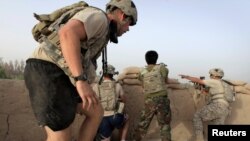The United States will face substantial hurdles if it has to return to Afghanistan — even briefly — to deal with new or growing terror threats once the military completes the planned withdrawal of forces from the country, a top U.S. general told lawmakers.
The warning Tuesday from the commander of U.S. forces in the Middle East and parts of South Asia comes as military planners are still working on how to bring home all 2,500 to 3,500 troops in Afghanistan starting next month, ending two decades of war.
"I don't want to make light of it. I don't put on rose-colored glasses and say it's going to be easy to do," said U.S. Central Command's General Kenneth "Frank" McKenzie Jr. as he told members of the House Armed Services Committee of the possible need for future counterterrorism missions.
"We're examining this problem with all of our resources right now to find a way to do it in the most intelligent, risk-free manner that we can," he said. "It's going to be extremely difficult."
McKenzie told lawmakers Tuesday he has been ordered to provide Defense Secretary Lloyd Austin with options by the end of the month.
Other officials are also looking at potential solutions.
"Work is under way to adapt, adjusting to the security environment and consider how to continue to apply pressure," Amanda Dory, acting deputy assistant secretary of defense for plans and posture, told lawmakers.
"What I can say from the decision process that the president led with his national security team is that there was consideration of a range of scenarios for the future of Afghanistan," she added.
The lack of specifics, though, has worried Democratic and Republican lawmakers, and also former officials, since U.S. President Joe Biden announced his decision last week to move ahead with the withdrawal from Afghanistan.
The most recent U.S. intelligence assessments warn that without the presence of U.S. and coalition troops, the prospects for peace in Afghanistan "will remain low," and that any setbacks for Afghan security forces could give terror groups such as al-Qaida and Islamic State a chance to regenerate.
U.S. and Western intelligence officials say that al-Qaida is down to just a few hundred fighters in Afghanistan, but many of them continue to be on good terms with the Taliban and, in some cases, are integrated into the Taliban's existing command and control structure.
There are also concerns about Islamic State-Khorasan, as the group's Afghan affiliate is known. Intelligence officials say it has between 1,000 and 2,500 fighters and remains intent on conducting terror attacks against the West.
Some high-ranking officials, including the director of the CIA, have expressed concerns about being able to track these groups without any presence on the ground.
"The U.S. government's ability to collect and act on threats will diminish. That's simply a fact," CIA Director Bill Burns said last week, describing the risk as significant.
Richard Myers, a retired four-star general who served as chairman of the Joint Chiefs of Staff during the early years of the U.S. war in Afghanistan, said while there may be ways to compensate for the lack of intelligence, it is "a legitimate concern."
"I would hope that we have thought about that and have made other plans to make sure that we still have enough intelligence to know what those groups are doing," he told VOA's Afghan service. "Without that, I think there's a great probability that this could be a real danger for the rest of the world."
Yet despite such fears, the Biden administration has expressed confidence in what it describes as an "over the horizon" approach.
"We'll reorganize our counterterrorism capabilities and the substantial assets in the region to prevent reemergence of terrorists — of the threat to our homeland," Biden said last week when he announced his decision. "My team is refining our national strategy to monitor and disrupt significant terrorist threats not only in Afghanistan but anywhere they may arise."
In the case of Afghanistan, it appears to be a strategy that rules out the use of combat troops.
"There's no plans to reintroduce American boots on the ground in Afghanistan," Pentagon press secretary John Kirby told reporters Monday when asked by VOA about countering potential terror threats to the homeland.
"I know of no discussions with the government in Kabul about reinserting counterterrorism forces inside Afghanistan," he said. "We have robust counterterrorism capabilities around the world. … There's not a parcel of earth that we can't hit if we need to hit it."
Some analysts call such assessments overly optimistic, noting the U.S. has seen only limited success with a so-called whack-a-mole approach.
"CT (counterterrorism) efforts without boots on the ground is a losing proposition," said Bill Roggio, a senior fellow with the Foundation for Defense of Democracies, who has closely studied U.S. efforts in Afghanistan.
"You may be able to occasionally kill senior al-Qaida and Islamic State leaders, but successes will be few and far between," he said. "Jihadists are already based in Afghanistan, and their footprint will grow, and U.S. capabilities decrease."
There are other challenges, as well, including uncertainty about where the U.S. will be able to position counterterrorism assets, such as drones, in case they are needed.
"At this time, we have none of those agreements in place," U.S. Central Command's McKenzie told lawmakers Tuesday, acknowledging diplomatic discussions are under way with countries in the region to secure necessary permissions.
"We'll look at all the countries in the region," he said. "Some of them may be very far away."









